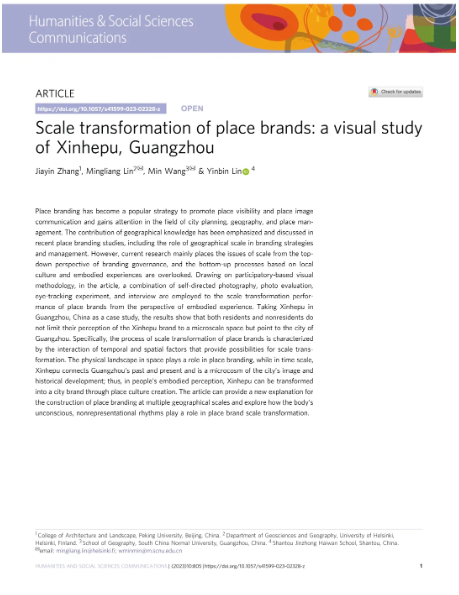科研动态Research News | 我院王敏教授团队在Nature旗下HSSC期刊发表最新学术成果
华南师范大学地理科学学院/学院新闻2023-11-19 15:55:00来源:华南师范大学评论:0点击:收藏本文
我院王敏教授团队在Humanities and Social Sciences Communications发表最新学术成果
Prof. WANG Min’s team have published a paper in the Humanities and Social Sciences Communications, a humanities and social sciences journal under the Nature umbrella.
作者简介
王敏,华南师范大学地理科学学院教授,主要从事人文地理、城乡规划、地理教育等方面的研究。主持国家自然科学基金项目3项,在国内外权威及核心期刊(SCI/SSCI/CSSCI)发表学术论文70余篇。

近日,华南师范大学地理科学学院王敏教授团队在Nature旗下唯一面向人文社会科学的期刊Humanities and Social Sciences Communications发表题为"Scale transformation of place brands: a visual study of Xinhepu, Guangzhou"的研究论文。(全文链接:https://www.nature.com/articles/s41599-023-02328-z)
该研究源于王敏教授2020-2021年指导的本科生毕业论文,论文的第一作者为地理科学学院2017级(2021届毕业)本科生章佳茵,在王敏教授的悉心指导下顺利完成。此后将学位论文成果转化为英文学术论文,历经多轮论文修改、实验完善以及反复讨论和分析,最终取得了阶段性的研究成果。
地方品牌已成为提升地方知名度和地方形象传播的流行策略,并在城市规划、地理和地方管理领域受到关注。在最近的地方品牌研究中,地理知识的贡献得到了强调和讨论,包括地理尺度在品牌战略和管理中的作用。然而,目前的研究主要从自上而下的品牌治理视角来定位尺度问题,而忽略了基于地方文化和具身体验的自下而上的过程。本文基于参与式的视觉方法论,从具身体验的视角,采用自助摄影、照片评定、眼动追踪实验和访谈相结合的方法,对地方品牌的尺度转换进行研究。以中国广州市新河浦地区为例,结果表明,无论是居民还是非居民,对新河浦品牌的认知并没有局限于微观空间,而是指向了广州市的城市品牌。具体而言,时空因素的相互作用为尺度转换提供了可能性。空间中的物理景观助力地方的品牌化,而在时间尺度上,新河浦连接着广州的过去和现在,是城市形象和历史发展的缩影;因此,在人们的身体尺度感知中,新河浦可以通过地方文化的营造,转变为城市品牌。本文可以为多重地理尺度下的地方品牌建构提供新的解释,探讨身体的无意识、非表征节律如何在地方品牌尺度转换中发挥作用。
Humanities and Social Sciences Communications是Nature旗下唯一面向人文社会科学的期刊,致力于出版人文、社会与行为科学所有领域的高水平研究,在国内外的人文社科领域具有重要影响力。2022年影响因子(IF)为3.5 ,为JCR一区,CiteScore为3。
Abstract
Place branding has become a popular strategy to promote place visibility and place image communication and gains attention in the field of city planning, geography, and place management. The contribution of geographical knowledge has been emphasized and discussed in recent place branding studies, including the role of geographical scale in branding strategies and management. However, current research mainly places the issues of scale from the top-down perspective of branding governance, and the bottom-up processes based on local culture and embodied experiences are overlooked. Drawing on participatory-based visual methodology, in the article, a combination of self‐directed photography, photo evaluation, eye-tracking experiment, and interview are employed to the scale transformation performance of place brands from the perspective of embodied experience. Taking Xinhepu in Guangzhou, China as a case study, the results show that both residents and nonresidents do not limit their perception of the Xinhepu brand to a microscale space but point to the city of Guangzhou. Specifically, the process of scale transformation of place brands is characterized by the interaction of temporal and spatial factors that provide possibilities for scale transformation. The physical landscape in space plays a role in place branding, while in time scale, Xinhepu connects Guangzhou’s past and present and is a microcosm of the city’s image and historical development; thus, in people’s embodied perception, Xinhepu can be transformed into a city brand through place culture creation. The article can provide a new explanation for the construction of place branding at multiple geographical scales and explore how the body’s unconscious, nonrepresentational rhythms play a role in place brand scale transformation.
Journal Information
Humanities and Social Sciences Communications is Nature's only journal for the humanities and social sciences, dedicated to publishing high-level research in all areas of the humanities, social and behavioral sciences, with significant influence in the humanities and social sciences at both domestic and international levels. The Impact Factor for 2022 is 3.5, JCR Q1, and the CiteScore is 3.

文字编辑 | 王 敏
初审 | 袁亚娟
复审 | 陶 伟
终审 | 刘云刚
标签: